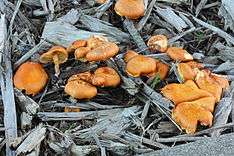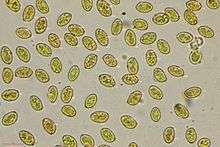Gymnopilus echinulisporus
Gymnopilus echinulisporus is a species of agaric fungus in the family Cortinariaceae. It was first formally described by American mycologist William Alphonso Murrill in 1912.[1]
| Gymnopilus echinulisporus | |
|---|---|
 | |
| Scientific classification | |
| Kingdom: | |
| Division: | |
| Class: | |
| Order: | |
| Family: | |
| Genus: | |
| Species: | G. echinulisporus |
| Binomial name | |
| Gymnopilus echinulisporus Murrill (1912) | |
| Gymnopilus echinulisporus | |
|---|---|
float | |
| gills on hymenium | |
| cap is convex | |
| hymenium is adnexed or adnate | |
| ecology is saprotrophic | |
| edibility: inedible | |
Habitat and distribution
Gymnopilus echinulisporus has been found growing on wood in Oregon in November.[2]

Spores 1000x
gollark: If there was no licensing, it would be possible for some cryoapioform to decide "hmm, I really want to communicate with some random person over here" and use an overpowered transmitter, thus drowning out all mobile phone reception nearby (on that frequency, at least, they can use several).
gollark: Things like mobile networks need large amounts of bandwidth available and not being interfered with to work.
gollark: It's right to transmit, not literally all control over that frequency ever.
gollark: It seems strange to sell off fundamental properties of reality, but spectrum is actually quite scarce for many uses.
gollark: You see, the government sells off portions of the electromagnetic spectrum for profit, and the 2.4GHz-ish region is one of the "ISM bands" for which basically-arbitrary use is permitted at no cost.
See also
References
- Murrill WA. (1912). "The Agaricaceae of the Pacific Coast – II. White and ochre-spored genera". Mycologia. 4 (5): 231–62. doi:10.2307/3753448.
- Hesler LR. (1969). North American Species of Gymnopilus (Mycologia Memoir Series: No 3). Knoxville, Tennessee: Lubrecht & Cramer. pp. 54–55. ISBN 0-945345-39-9.
External links
This article is issued from Wikipedia. The text is licensed under Creative Commons - Attribution - Sharealike. Additional terms may apply for the media files.